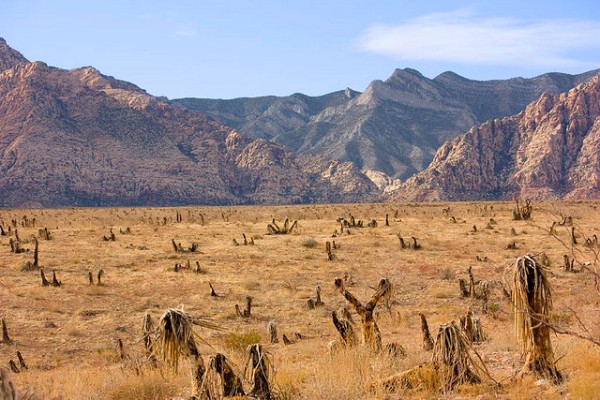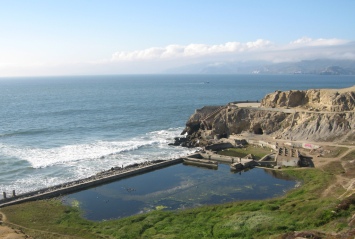Battleborn – Claire Vaye Watkins
Riverhead / Granta Books – 2012

“He looked around and saw no one, only dirt and mountain and sky.”
Junot Díaz and Dan Chaon are both well-established writers, whose command of the short story form is admitted by many, critics and readers alike. Both were finalists for the 2013 Story Prize (for This is How You Lose Her and Stay Awake respectively), but lost the competition to a third contender, American writer Claire Vaye Watkins’ literary debut: Battleborn. And this award is certainly a very well deserved one for an outstanding first collection.
Battleborn draws its title from Nevada – the Battle-Born State – and it is a very fitting title indeed: these ten stories, deeply anchored in the “unfathomable American landscape,” deal with battles and births, both literal and symbolic, with characters striving to gain recognition or affection from others, or more generally struggling with how to deal with a lingering past.
This predominance of the past in the collection is explicitly tackled in “The Past Perfect, the Past Continuous, the Simple Past,” in which an Italian tourist whose friend got lost in the desert and is going to die there accidentally ends up paying regular visits to a prostitution ranch, where he will gradually manage to accept his loss as part of the past, something that was.
Likewise, “Ghosts, Cowboys,” the opening story, is Watkins’ essayistic take on her own heavy family history. Paul Watkins, Claire’s father, was, in the 1960s, Charles Manson’s right-hand man and active member of the cult surrounding the iconic American criminal. The story relates an episode from this period, but what matters most here is not so much the events themselves as what Watkins makes of them. Instead of falling into the temptation of easy sensationalism, giving yet another account of facts that have been written about many times before, she uses her genealogy to put forward the thematic and aesthetic project at the core of the collection, an exploration of what she/her character coins “the inadequate weight of the past” :
I wanted to tell him what I told you, but that’s nothing that can’t be found in a book, a diary, a newspaper, a coroner’s report. And there’s still so much I’ll never know, no matter how much history I weigh upon myself.
Just as Watkins’ personal story is embedded within a wider national history, “Ghost, Cowboys” deals both with the History of Nevada itself, starting with the foundation of Reno, and with its inhabitants, then proceeding to list other possible starting points for the story, announcing Watkins’s interest in the very act of story-telling, of literally telling one’s story. The text begins, “the day my mom checked out, Razor Blade Baby moved in. At the end, I can’t stop thinking about beginnings,” thus heralding the underlying self-reflexive dimension of the collection.
The most significant and well executed example of this self-narration is “The Last Thing We Need”, a story that stands out in its original structure and treatment. On his way to Rhyolite, the protagonist finds what appear to be the remains of a car accident. The debris includes cans of coke, broken glass, some groceries, along with medication and a sealed bag of letters signed “M.” The character writes a first letter to the man whose address is on the prescriptions, and asks a series of questions: “What happened out there? Where is your car? Why were the medication, food and other supplies left behind? Who are you, Duane Moser? What were you looking for at Rhyolite?”
The curiosity of the reader is aroused by these mysterious elements of a nascent plot, but these questions, just like the character’s subsequent letters, remain unanswered and are relegated to a position of lesser relevance. What Watkins slickly manages to do here is change the focus from an expected plot-driven story to a more introspective character-centred approach. As the protagonist grows more and more anxious and eager for replies to his letters, he progressively transfers his interest in what happens on the road into a confession of his own past traumas, memories triggered by the scene of the accident and casually, perhaps unconsciously referred to in the first letter, when he mentions a picture of a car found in the debris: “The car was a Chevy Chevelle, a ’66, I believe. I once knew a man who drove a Chevelle.” This story is Watkins excelling at something she does in other parts of the collection; smoothly allowing form and storytelling to prevail over plot and events by concentrating on character.
Character in Battleborn is inseparable from landscape. The Nevadan background is both an extension and a reflection of the characters. Setting – ranging from adobe towns and blistering deserts to brothels and museums – is used to emphasise the loneliness of Watkins’ outsiders: “There’s nothing but the lolling violet mountain range and spiny yucca and creosote and that taut of ribbon as far as the eye can see.”
In “The Diggings,” the longest story, Watkins distances herself from the contemporary settings of the rest of the collection to depict an episode of another (after the Manson Family saga) emblematic moment of American History. In 1849, two brothers become prospectors and venture into the Gold Rush, one to earn the love of a woman, the other to earn the esteem of his brother. If the beginning reads like a rather classic adventure story, it rapidly evolves towards an investigation into the darkness and the madness of what the narrator calls “the territory.” It is one of the strongest pieces of the collection, in its almost mythological dimension – the two brothers fancy themselves as “brother Argonauts, bold and divine” – its vivid description of violence (one striking scene depicts very graphically the fight between a bear and two bulls) and its exploration of the self, dug up like gold-rich ground: “The mind is a mine. So often we revisit its winding, unsound caverns when we ought to stay out.”

“… I can’t look out at the sea without imagining it filled with the waterlogged corpses of boys and polar bears.”
The general flavour of Battleborn is one of bleak misery, most of the stories being rather grave, despite the recurrence of the theme of birth in the collection. Contrary to what might be expected, the prospect of having a baby is rarely a happy one but rather a source of anguish and existential doubt. Half of the stories feature young mothers or pregnant women. In “Man-o-War,” a teenage girl is found unconscious in the desert by a recluse after she got her boyfriend to hit her belly to get rid of her unwanted baby. In “Wish You Were Here,” a woman with bad eating and living habits resents her partner for trying to turn her into a double of his own healthy and balanced mother, so their baby can be looked after properly: “They fight about these things before the child is more than a wafer of cells. Before the child is anything, it is a catalyst for fights.” This dreaded transformation into a domestic and obedient mother and wife is aptly evoked as she helps her step-mother cook, and the neatness and tight orderliness of her life to come stares her in the face:
She opened the door of the pantry to reveal a wall of hand-canned fruits and vegetables. The stained-glass colors of tomatoes, yellow squash, zucchini and green beans. Carrot spears, halved beets, apricots, rings of apples. Small shrivelled pickles and relish and a row of homogeneous dun-colored jams. Pearl onions like eyeballs.
But this birth-related angst is most interestingly and effectively probed in “The Archivist” and “Graceland,” two variations on a very similar situation: two motherless sisters trying to process the loss of their mother as they negotiate the imminent arrival of a baby in their lives. On a superficial level, the story of “The Archivist” could be dismissed as slightly conventional: a young woman leaves her perfectly caring and loving partner for a much harsher man, who will eventually leave her in turn, “a cokehead flimflam man who left me with a nicotine addiction and some trash from his pockets,” as she puts it. Here again, Watkins manages to render her character’s turmoil in a way so accurately convincing that the story both escapes from and cancels the apparent superficiality of the situation.
What makes the narrator’s voice so unique is her imaginative way of coping with her destructive past relationship, by keeping all the items her ex left behind him
I decided I would preserve them just as he’d left them, convert my apartment into the Museum of Love Lost. I envisioned other exhibits. An installation of all the clever, evasive text messages he ever sent me, a replica of the bar where we met, handmade dioramas of our finest outings.
But the deeper roots of her affliction, brought to the surface by her pregnancy and the exemplariness of her sister Carly’s baby, lie in her earlier history and her concerns for her child. As she realises the risks of wrecking her baby like she has been wrecked by her own mother, she reflects upon the source of her grief:
When Carly was pregnant with the Miracle she tried never to become upset or angry, always to be calm. That was why the Miracle turned out so even. But it seemed all I was was upset and angry. It is such a short distance from the heart to the womb. I could see foul chemicals injecting into Cranberry. What if the first feelings she ever felt were loss and fear and anger? It must sour a person profoundly to have these as first feelings. This is probably what happened to me.
The characters in one story drive pass a billboard that reads “Virgina City: A Town of Relics and Memories and Ghosts of the Past,” providing a perfectly suitable insight of what Battleborn is, a fictional vision of the American West, peopled with scarred outcasts haunted by their pasts; a set of individuals born in battle and battling from birth. It deserves recognition for the sheer quality of its writing, the depth and accuracy of its characterisation, and the beautiful evocations of the Nevadan landscape. Watkins has produced a text so consistently good it is hard to believe it is the debut collection of a young writer. These ten ambitious stories are skilfully structured, filled with powerful imagery and carefully crafted prose. Battleborn is the work of an elegant, confident and talented writer.
More information on the book on Claire Vaye Watkins’ website and her American and British Publishers’ websites.
Battleborn has been longlisted for the 2013 Frank O’Connor International Short Story Award.
Picture credits: 1. by Tela Chhe – Flickr / 2. by ElisDragon – Flickr
